How to recognize why a plant turns yellow?
Even in the absence of a negative effect, greens on an orchid can acquire a yellow tint. This is due to age-related changes. Over time, the flower ages, which causes the death of the ground part.
The rest of the causes of pathology are easy to determine by the characteristics of yellowness:
- If the leaf has lost tugor, weeping spots have appeared on it, most likely the problem is damage to the root system (mite, root rot, excess moisture).
- Dry spots indicate sunburn.
- Sluggish leaves, the appearance of yellow, black or brown spots and bumps are characteristic of infections.
- White bloom indicates the presence of parasites.
- Sharp yellowing and shedding is typical for plants that have undergone stress.
What causes the trunk and stems to fade?
The wilting of the stem of a plant can be a serious symptom. Often this is followed by the death of the flower. The trunk can wilt for several reasons:
- stress;
- dying off of the point of growth;
- natural process.
Sooner or later, the flower will begin to wither and wither from old age. This is a natural process that cannot be stopped. By changing the point of growth, the culture also cannot be saved.
When an orchid is moved from the usual conditions of the store to an apartment, the process of wilting is explained by the transferred stress. To get rid of its consequences, it is enough to provide the flower with peace and acceptable conditions (for the entire period of adaptation).
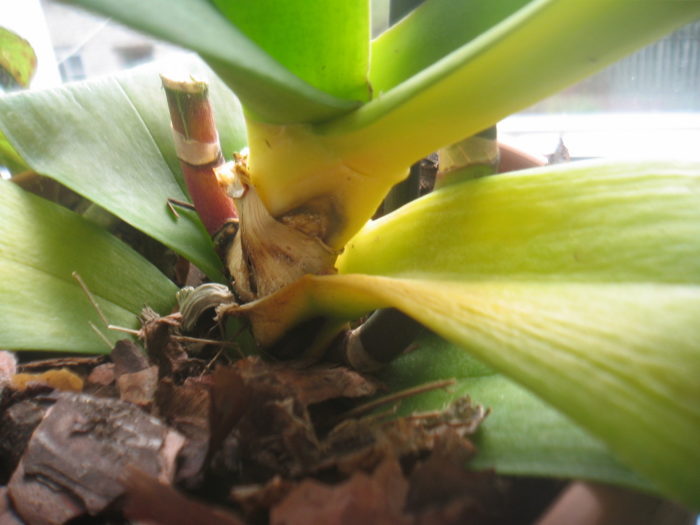
What is the reason for the wilting of the roots?
Sometimes, in the presence of a healthy-looking ground part, the roots of the orchid begin to disappear. Sooner or later, this will deprive the flower of the ability to receive nutrients, and it will die.
In order to provide the necessary assistance in a timely manner, it is important to correctly determine the causes of this phenomenon:
- overflow - leads to decay of the roots;
- root mites and other insects also damage the roots of the plant;
- a pot of the wrong size;
- fungal and viral infections.
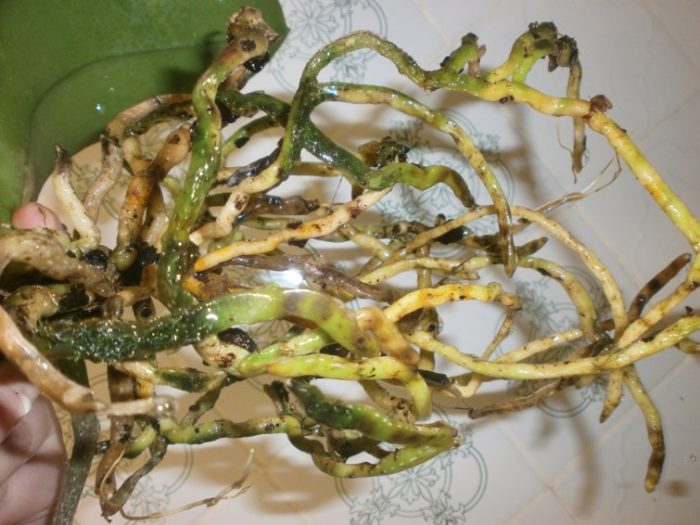
Why do yellowed leaves fall?
The yellowed leaf should fall off. All natural metabolic processes stop in it, and it naturally dies. This will happen regardless of the cause of the yellowing.
Falling leaves are typical for such problems:
- transferred stress;
- aging plants;
- root damage;
- overflow or drying out.
Reference! The only exception to the rule is sunburn. In this case, the entire leaf does not die: it is enough to remove the affected area, and the healthy plate will continue to exist.
Prophylaxis
In order for your flower to remain healthy and delight you with beauty and attractiveness all year round, you must follow simple preventive measures:
- Spraying it regularly with warm water will help prevent drying out and pests.
- Alternate between dripping and submersion in a container of water.
- Do not cut the peduncle after flowering, you need to wait until it dries completely.
- When transplanting a flower, use a better purchased substrate - it does not contain pathogenic microflora and is enriched with all the necessary trace elements.
- To avoid drying out, the surface of the earthen coma is covered with a small layer of sphagnum moss.
- Do not transplant in the budding and flowering phase, so as not to destroy it.
- An orchid that is fading should be moved to a cooler room, reduced watering and moderate humidity. In such conditions, it will fully survive the dormant stage without losing its decorative effect.
Orchid leaves turn yellow - reasons
There may be several reasons for this problem, they are divided into natural and pathological.Natural causes of yellowing of leaves include:
- plant age;
- transplant stress;
- the natural process of dying off the lower leaves during the growth of the orchid.
Pathological reasons include the following factors:
- improper watering;
- lack of light;
- incorrect arrangement of the flower - draft, direct sunlight;
- damage by bacteria and fungi;
- pests;
- lack of space in the pot;
- improper care - lack of nutrients or their excess.
If the leaves of an orchid turn yellow for natural reasons, this indicates the inexperience of the grower. A flower that has just been purchased is not recommended to be transplanted immediately, it is necessary to give time to adapt. This period is called quarantine and must last at least two weeks. Orchid purchased from a store, as a rule, is in a state of vigorous flowering and does not need to be transplanted.
Leaves can turn yellow due to the stress that any plant experiences when changing rooms or replanting. Orchids should not be repotted frequently, once every two years is enough. As a guide, you can use the state of the leaves, they primarily react to a lack of nutrition or space in a flowerpot. Pathological reasons can cause not only yellowing of the leaves, but also the death of the plant, so each factor should be considered separately.
Excessive or insufficient watering
Insufficient watering of the orchid may be due to the incorrectly chosen method of moistening the soil. If you water the orchid through the top, then the root system does not have time to absorb enough moisture, the water simply flows into the pan. This is also due to the peculiarity of the soil in which the plant is planted.
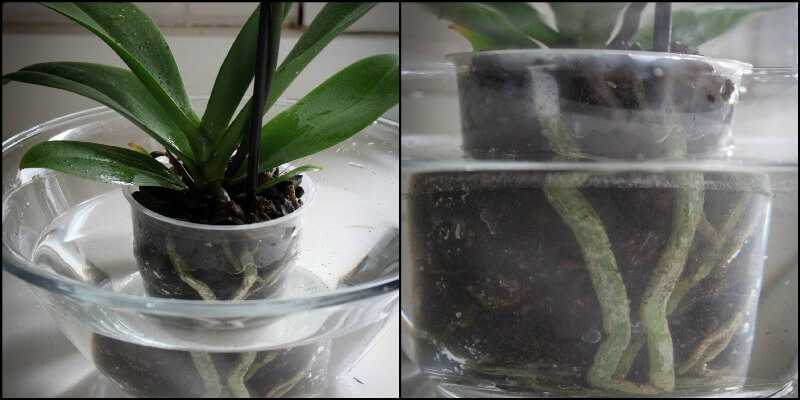 Watering by immersion photo
Watering by immersion photo
The orchid must be watered using the immersion method:
- pour water at room temperature into a shallow basin and immerse a pot with an orchid there;
- wait until the plant is drunk and remove the pot from the basin (you can determine this by the roots of the orchid - they will become green and fleshy);
- when excess moisture drains, the plant can be placed in a tray and returned to its place.
With this watering, the flower will quickly recover, the leaves will stop turning yellow, but the main thing is not to overmoisten the soil, this can also cause yellow leaves. To avoid problems with watering for orchids, pots are made of transparent material - glass or plastic.
To save the plant, it is necessary to stop watering, let the soil dry out and set the watering regime in accordance with the ambient temperature and season. If the process of rotting of the root system has begun, the orchid must be removed from the pot, the damaged leaves and roots must be removed, and the flower must be transplanted into a new soil.
Excess or lack of sunlight
If the orchid stands on the windowsill of the north or west window, then it is unlikely to receive a sunburn. But if in the east or south, direct sunlight will surely burn the leaves, which will cause them to turn yellow. Signs of leaf sunburn are the following:
- yellowness on the leaves appears in places, only where direct sunlight has hit;
- over time, the leaf around the burn dries out completely.
 Phalaenopsis orchids air humidity photo
Phalaenopsis orchids air humidity photo
In order to help the plant, it must be rearranged to another place, a healthy flower will cope with the burn itself if the affected area is relatively small.
If all the leaves of an orchid turn yellow, the reason may lie in a lack of light. In winter, fluorescent lamps should be used as additional lighting. It is only recommended to turn them on for a few hours to extend the daylight hours. In winter, the orchid is in hibernation, its life processes are slowed down, so you should not overheat the plant.
The unopened bud began to dry: what to do?
Orchid owners often observe the drying of unblown buds.As in the case of yellowing of the leaves, this is caused by a violation of the conditions of detention. The buds dry out:
- low or high room temperature;
- lack of sunlight;
- violation of the irrigation regime;
- lack of nutrition.
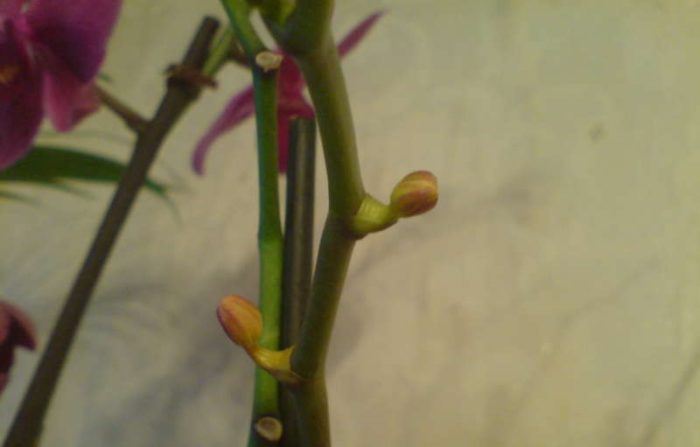
To get rid of the problem, it is enough to eliminate the negatively influencing factor. The flower pot is moved to a more suitable place, additional lighting is provided and the method of watering is redefined.
Reference! Sometimes changing root watering to irrigation through drainage holes helps. In this version, the flower will absorb as much moisture as it needs.
How to save blooming Phalaenopsis?
If the plant begins to disappear during flowering, most likely it will not be possible to save the peduncles. Keeping the entire plant, they are pruned first. This relieves the orchid of the need to provide nutrients to the flower, helping to focus on rebuilding the ground portion.
To save Phalaenopsis, you need to do the following:
- Examine the plant and determine the cause of wilting.
- Remove peduncles.
- Carry out parasite treatment (if necessary).
- Treat with root preparation (if damaged).
- Provide the flower with suitable conditions for keeping.
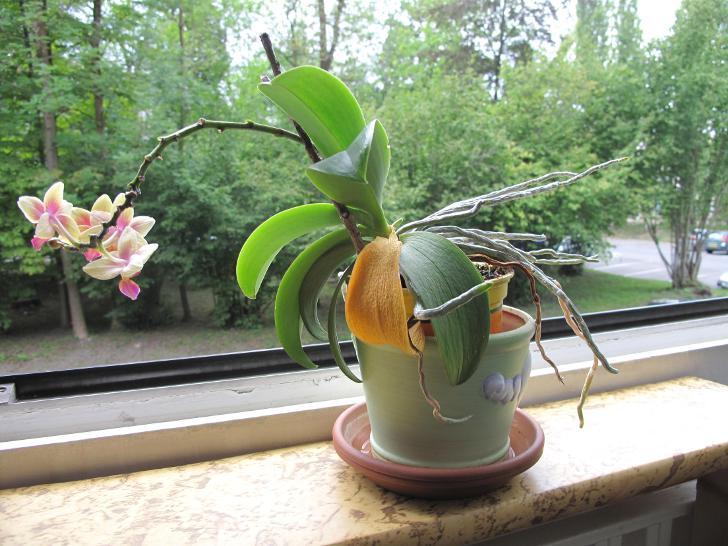
If turned yellow after transplant
Yellowing after transplanting may indicate root rot. In addition, the leaves may turn yellow if the adaptation period is not maintained after the purchase of the flower. A transplant immediately after purchase is a double stress.
If yellow leaves appeared after transplanting and the plant began to wither, it should be urgently reanimated:
- Take the flower out of the ground.
- Examine the roots.
- Remove all damaged areas.
- Immerse in water for a couple of hours so that the root system is saturated with moisture.
- Place the plant in a mini greenhouse.
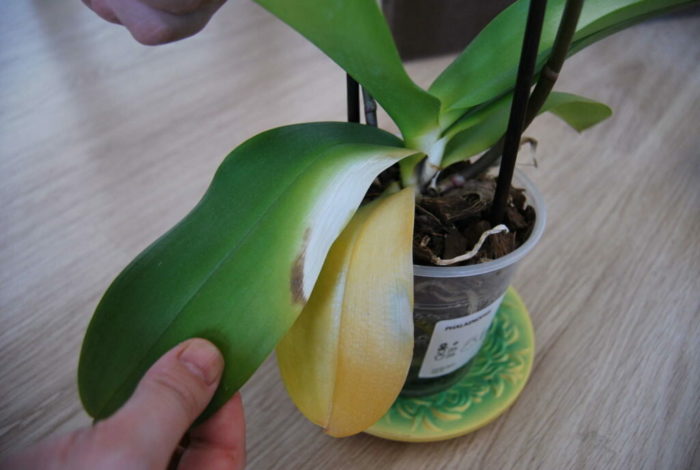
The peduncle turned yellow: will it bloom?
If a barely noticeable yellowness appears on the peduncle, you can try to correct the situation. To do this, it is worth analyzing: whether the conditions for keeping the flower meet the established standards. Sometimes you can slow down or stop the yellowing process of the peduncle by moving the orchid to a more suitable place and adjusting the watering mode.
If the process has already gone too far, it is better to remove the peduncle. This will help preserve the rest of the plant. The peduncle is removed in the following cases:
- the orchid is weakened by disease and is unable to nourish the flower;
- the plant needs a rest period to recover from stress;
- the peduncle is completely dry.

Reference! When the peduncle dries out from below, it is better to remove it immediately. This condition can be dangerous for the orchid.
Why does an orchid need special care?
Phalaenopsis feels great in the humid and warm climate of the tropics. It is rather difficult for him to survive in our regions. This is due to several negative factors inherent in city apartments:
- dry air;
- not enough sun;
- short daylight hours in winter;
- temperature difference.
It takes a lot of work to achieve an attractive appearance and regular flowering of orchids. Hybrid varieties are called especially capricious. If the conditions of detention are violated, the flowers can hurt, lose their decorative effect and even die.
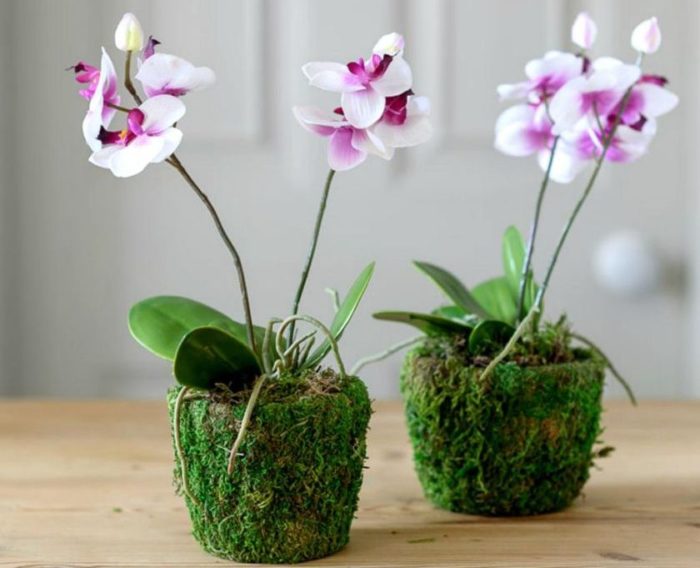
Emergency assistance

What to do if the orchid leaves turn yellow:
- If burns appear on the leaves, you must immediately move the plant to a shaded place. It is desirable to provide bright, but diffused light without direct sunlight. Affected leaves do not need to be removed; with minor damage, the plant will recover on its own.
- A common cause of yellowing of leaves is insect larvae that suck juices from the fleshy parts of the plant. They can be found on the underside of the sheet. Pests are washed off with a warm soapy solution, wiping the leaves, petioles and leaf sinuses with a damp cotton swab. In this case, the earth must be covered with film or foil.The treatment is repeated for 2-3 weeks until the complete disappearance of the parasites.
- If the tips of the leaves turn yellow and dry on the flower, the reason may be overfeeding with mineral fertilizers with potassium. The plant must be removed from the pot, rinsed the roots with warm, settled water, and then moved to a container with fresh substrate. The best choice is a special primer for orchids. After transplanting, you can feed the orchid only after a month.
- With insufficient watering, the leaves dry out, turn brownish-yellow and quickly fall off. To save the orchid, you need to place the pot in water. When the earthen lump is completely saturated with moisture, the orchid is taken out, and the procedure must be repeated a day later. It is advisable to check the condition of the drainage: a layer that is too thick quickly removes moisture, preventing it from penetrating to the roots.
The lower leaves turned yellow

The discoloration of the lower leaves is a natural process. Old shoots gradually die off, and new ones take their place. Do not try to tear off the leaves that have lost their beautiful appearance as soon as possible, as this can injure the stem. It is better to wait until the old leaf withers on its own, after which it can be removed.
The stem turns yellow: what to do
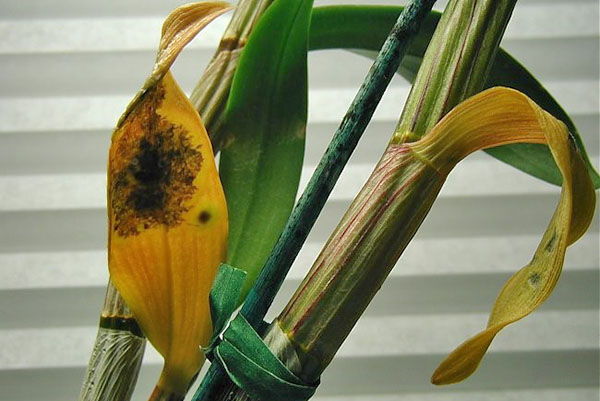
The orchid stem may turn yellow due to mechanical damage. As a result, the growth point shifts, part of the stem turns pale, then dries up and gradually dies off. This can be avoided by treating the injured plant with an antiseptic and providing it with comfortable conditions: moderate heat, proper watering, bright but diffused light.
Orchid got sick after transplant

Transplanting is stressful for any plant, and many orchid species are particularly sensitive to this procedure. A plant grown in greenhouse conditions painfully responds to too dry air and an improperly selected substrate
It is very important to choose a pot of the right size. For successful development and flowering, an orchid needs tightness, otherwise the roots will begin to grow rapidly to the detriment of the formation of buds
The ideal diameter of the pot exceeds the volume of the root ball by no more than 5 cm. It is advisable to choose a transparent plastic container, it will allow you to control the state of the earthen coma.
Yellowing leaves of an orchid do not always indicate serious problems. Urgent action is needed if most of the greenery changes color and the leaves dry and fall off. Making adjustments to the care program will help save the plant and restore its attractive appearance.
The main causes of diseases
It is rather difficult to identify the most likely cause of Phalaenopsis disease. Most often, the problem is caused by a whole complex of different reasons. The most common ones are:
- Insufficient humidity in the room;
- Lack of effective drainage and stagnation of water in the soil;
- Lack of feeding or incorrect (irregular) feeding;
- Intervention of insect pests and parasites.
Infection with dangerous fungal, viral, bacterial infections can be caused by transplanting a plant into a pot filled with soil brought from the street. Therefore, in order to prevent wilting or yellowing of the tips of the leaves, it is recommended to use only a special soil for indoor plants purchased from a specialized store.
Drying and wilting of leaves are very often caused by sunburn.
Attention! Phalaenopsis does not like direct sunlight, so experts recommend keeping the orchid in partial shade in summer, otherwise the plant can be lost: the leaves will begin to curl, then dry out. Choosing top dressing, you should give preference to preparations with a high concentration of nitrogen, potassium, phosphorus
It is these substances that the orchid needs for a set of green mass, proper development of leaves, active growth and long flowering.
Choosing top dressing, you should give preference to preparations with a high concentration of nitrogen, potassium, phosphorus.It is these substances that the orchid needs for a set of green mass, proper development of leaves, active growth and long flowering.
The causes of diseases are sometimes pests and parasites: scale insects, spider mites, nematodes. In this case, to resuscitate the plant, it should be treated with insects. When the pests disappear, the leaf plates will become healthy again. The invasion of voracious aphids especially weakens the vitality of the orchid; you can fight it at home with the help of spraying.

Most often, illnesses are caused by improper care
Why did all the leaves of the orchid fall?
With improper care, such a situation is possible - there are roots, quite healthy and in sufficient quantity, and the leaves completely fly around.
The most common cause is excessive moisture, and water stagnates in the outlet. As a result, the leaves rot away.
The second reason is fusarium wilting. It is a disease that is caused by mold fungi. They spread toxins, the leaves begin to rot.
The development of the disease is also facilitated by high humidity, especially in combination with a lower soil temperature. Saline or acidic soil is the most favorable environment for these fungi.
How to save an orchid without leaves?
Resuscitation of a leafless orchid:
- With a sharp, well-sharpened tool, carefully cut out all the rotten areas without any regret. If even a little bit of damaged tissue remains, the decay will continue.
- Sprinkle the slices well with sulfur or cinnamon powder, charcoal or activated carbon. Do not use Zelenka and iodine - they will burn healthy tissues.
- When the slices are dry, buy the plant in a fungicide solution.
- Place the orchid in a well-lit place, in conditions of absolute dryness and warmth not lower than 20 °.
- Leave it there for 7-8 days, periodically examining it. If damaged areas are found, cut and decontaminate.
- When the threat of further development of the disease disappears, assess the damage. If the growth point has rotted away, all hope is for the appearance of children, from which a new orchid will grow.
- Plant the plant in a good substrate, it is advisable to cook it yourself, since the store contains peat, which increases the acidity.
- Carefully observe the watering regime, in no case, do not flood the remains of the plant. The soil should dry completely between waterings.
- Be patient, as it may take a whole year to grow babies. For stimulation, you can use cytokinin paste, which is coated with all dormant kidneys. Leaves will grow back much faster if they have a healthy growing point.
Another tip on how to revive an orchid without leaves? If the leaves do not want to grow back during the resuscitation process, then they lack nutrients. It is necessary to increase the amount of fertilizers containing nitrogen. You can use special fertilizers to stimulate the "Dr. Foley Strong Leaf" type.
The appearance of various problems in capricious epiphytes requires an immediate solution. The main thing is not to despair and not give up, because the orchid is considered one of the most resistant plants. There are many known cases of the revival of beautiful flowers from almost nothing.
Types of orchids and the reasons for their yellowing
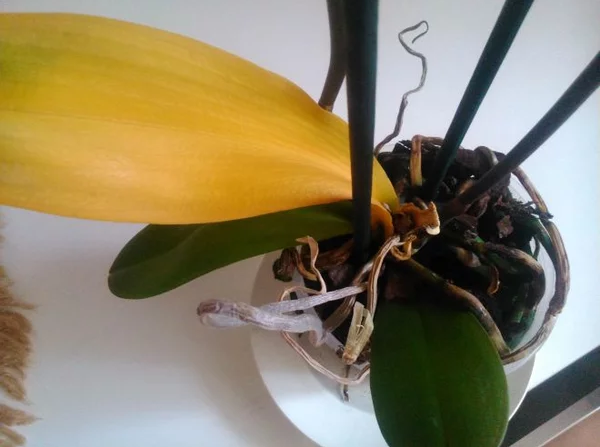
Botanists count at least 30 thousand species of orchids, including hybrids. But not all of them are suitable for home cultivation, and most of these flowers grow in the wild or in greenhouses. The most unpretentious flowering specimens are suitable for apartments: phalaenopsis, dendrobium, cattleya, pafiopedilum, cymbidium.
Novice and experienced flower growers often face the problem of yellowing, withering and falling orchid leaves. At the same time, the plant slows down its growth and stops tying new buds. There are several reasons for this phenomenon:
- incorrectly performed transplant;
- excessive or insufficient watering;
- lack or excess of fertilizers;
- attack of insect pests;
- natural aging and replacement of shoots;
- lack of light;
- sunburn;
- too high temperature in the room.
Why Phalaenopsis turns yellow
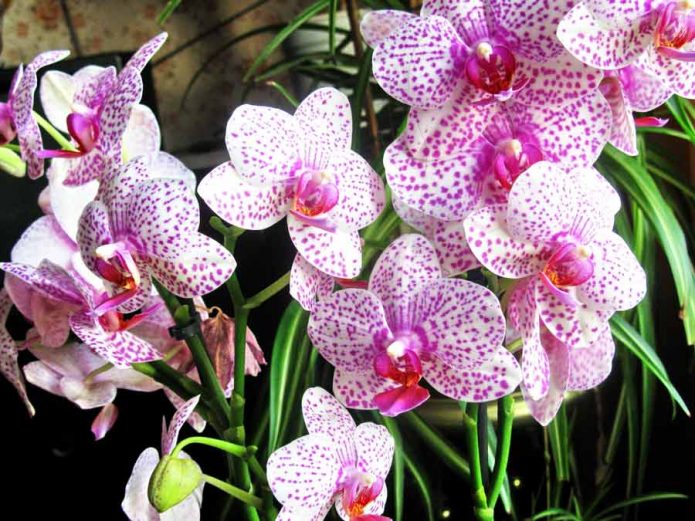
Phalaenopsis is one of the most popular orchids, often found in homes. The peculiarity of this plant is its shade tolerance. Phalaenopsis feels great on northern windows, and direct sunlight can negatively affect the state of its leaves and stems. The plant needs regular feeding with complex fertilizer for orchids and in a compact pot, where the bulb is planted without deepening. Yellowing leaves can indicate a lack of moisture, too dry air, or a high temperature in the room.
Causes of yellowing of dendrobium
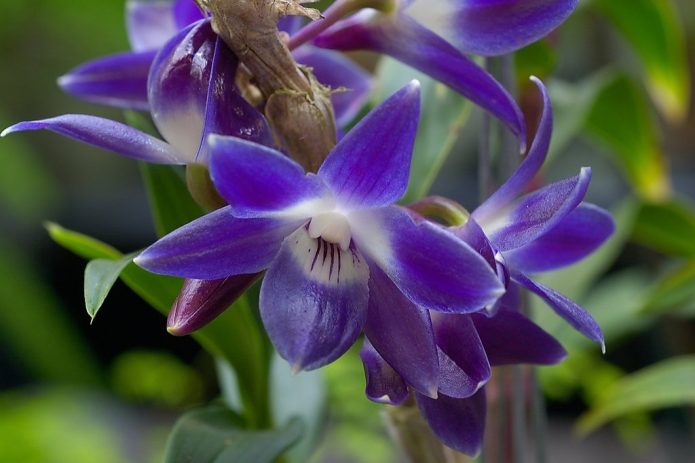
Dendrobium is a showy plant with a garland of large flowers, beautifully interspersed with narrow leaves. This type of orchid is quite demanding on temperature and humidity levels. He equally badly tolerates waterlogging and drought, does not like extreme heat and reacts negatively to drafts. The ideal microclimate for dendrobium is warm, moderately humid, stable. The yellowing of narrow, dark green leaves can be caused by direct sunlight, improper watering, or too high or low temperatures. Often, pests are the culprits of problems: scale insects, aphids, spider mites.
Cymbidium: an unpretentious flower with features

Cymbidium is a beautiful flower with straight peduncles, strewn with large bright buds. Differs in lush dark green leaves that retain their decorative effect for a long time. In order for the greens to have a beautiful color, it needs a bright diffused light (backlight is needed in winter and autumn). Cymbidium can wither in a room with too dry air; regular ventilation without strong drafts is useful for it. It is advisable to maintain daily fluctuations in temperature, at night the flower prefers coolness. In the warm season, the cymbidium feels great on the balcony or veranda. Leaves and stems must be protected from mechanical damage.
Major pests
The green aboveground parts of the plant are very delicate, so they often become a tasty morsel for a variety of pests, which can also cause yellow leaves (Figure 5).
Among the common pests of indoor orchids are:
- The spider mite feeds on the sap of the plant, and the stems of the leaves are covered with small dots (bite sites) and cobwebs. A sick flower must be immediately isolated from the rest so that the pests do not spread, and all the leaves of the affected specimen are thoroughly washed with a solution of laundry soap.
- Aphids not only change the color of the leaf plate, but also cause a sticky plaque to appear on its surface. To eliminate aphids, you need to wash the orchid with soapy water and spray with Fitoverm.
- The scutellum is an insect that is difficult to eliminate, since its body is covered with a dense shield. It is easy to find a pest: when a scabbard is damaged, characteristic growths appear on the surface of the plant. To combat the pest, you can use folk remedies, such as ammonia or a mixture of water with vegetable oil, but it is better to use special preparations for this purpose, for example, Actellik.

Figure 5. The main pests of the flower (from left to right): spider mites, aphids and scale insects
Violation of irrigation regime
One of the most common causes of yellowing of leaves is considered to be a violation of the watering regime, and the pathology can be caused by both excessive and insufficient moisture.
Since orchids live in the tropics, they are very sensitive to moisture, so the irrigation regime should be clear and fully consistent with the characteristics of the plant. Consider what happens to flowers with excessive and insufficient moisture.
Excessive moisture
To give the flower enough moisture, it is recommended to put the plant pot in a larger container filled with water.In this case, the pot should be submerged in water by about a third. However, it is not recommended to leave the plant in water for a long time, since in this case the soil moisture will be increased.
When over-watering, the following happens: the soil is so saturated with moisture, and sufficient oxygen does not flow to the roots. As a result, the root system simply cannot supply the aboveground parts of the plant with useful substances and the leaves of the flower begin to turn yellow (Figure 2).
 Figure 2. Signs of excess moisture
Figure 2. Signs of excess moisture
In addition, it should be borne in mind that in a humid environment, fungi and bacteria often begin to develop, provoking various diseases, which can also change the appearance of the flower.
Insufficient watering
Not only an excess, but also a lack of moisture can provoke yellowing of the leaves in an orchid (Figure 3).
Moreover, this process occurs much less frequently than a change in the color of a plant due to excessive watering, and to eliminate it, it is enough to add enough moisture to the soil. But before the procedure, you need to check whether the plant really does not have enough water. If your crop has an opaque pot, simply remove a few pieces of bark to gauge the moisture content of the soil inside. You can also pierce the ground with a wooden stick: if it becomes wet, then your flower does not need additional watering, and the reason for the yellowing of the leaves is an excess of moisture.
 Figure 3. Symptoms of lack of moisture
Figure 3. Symptoms of lack of moisture
It is easier to assess the degree of soil moisture in a transparent pot: it is enough to assess the color of the roots. They should be light green and pearlescent. Over time, you will learn to determine the need for watering simply by the weight of the pot: if it is light, then the soil inside is dry.
Exotic beauty treatments
Drying sheet plates
Orchid leaves turn yellow, what should I do? Experienced flower growers answer this question that again everything depends on the reason. So, if the leaf dries up and turns yellow according to the natural cycle, then you cannot touch the leaf plate. Despite her condition, she continues to feed the plant. You just have to wait, the sheet should dry and fall off on its own.
It's another matter if the drying leaves indicate more serious problems, for example, infections.
In this case, a broad-spectrum antibiotic should be used. A fungicide is suitable, for example:
- Alirin;
- Mikosan;
- Copper sulfate;
- Bordeaux liquid;
- Quadris, etc.
It is necessary to treat the plant, guided by the advice of the instructions. The pre-dried leaf is removed.

Signs of infection
Restoration of yellow leaves
If the leaves have not dried up at all, and the reasons are not infections, but the wrong content, then it is not difficult to restore the plant in this case.
Lighting
Among the main reasons for yellowing of leaves is a lack of lighting. In this case, the plant is placed on a bright area, best of all on the east or south side of the apartment. A little shading is required. In autumn and winter, additional lighting is needed in the form of fluorescent lamps.
Eliminating solar activity
If chlorophyll is no longer produced due to sunburn, the plant is rearranged to a different location. If the sheet is badly damaged, it is removed.
Note! Artificial lighting must also be installed correctly. You can not place lamps relative to the plant at a distance closer than 15-25 cm
Organization of correct watering
If the plant received less water, its roots began to dry, measures should be taken. It is best to remove the flower from the container with the substrate and immerse it in a container with warm water. Immersion occurs only in the root system. You cannot wet the green mass.
It is also possible to save the plant, which, on the contrary, has been flooded. For this, the rhizome is removed from the pot and examined for putrefactive destruction. If they are not there, then the roots are slightly dried and transplanted into a pot with new soil.
Working with feed
If the plant is overfed, it is removed from the pot, the roots are washed in warm water and transplanted into new soil. After 14 days, it is allowed to add a combined preparation for orchids of weak concentration. If the leaves turn yellow due to a lack of elements, then feeding should be organized.
Transfer
An important condition for the health of an exotic beauty is finding the optimal volume in the pot. Yellow leaves may indicate the need for a transplant.
In this case, the plant is transferred to a larger container.

To give a flower health, it must be transplanted on time.
Rhizome treatment
The flower will disappear if the decayed roots are not treated. First, the roots are examined. Brown color and fragility indicate impending doom. It is necessary to treat the plant promptly:
- The roots are gently cleaned of the substrate by hand.
- A sharp knife is taken. It is disinfected with an alcohol solution.
- With a knife, fibrous, rotten, dead parts of the rhizome are cut off.
- All places that the knife touched are processed with brilliant green. Ash can be used instead.
- Next, the plant is transplanted into a new soil.
- Watering for the first 3-5 days is prohibited. It is best to place a basin of water next to it. Water will humidify the air around the exotic.
Why do orchid leaves turn yellow?
 There are many reasons why orchid leaves turn yellow. Normally, the leaves of an orchid should be green, but it also happens that the leaf of an orchid turns yellow.
There are many reasons why orchid leaves turn yellow. Normally, the leaves of an orchid should be green, but it also happens that the leaf of an orchid turns yellow.
A change in their color to yellow is a signal indicating any disturbance in the normal life processes of the plant. And there are plenty of factors contributing to this.
Let's figure it out in more detail:
- Why do the lower leaves turn yellow in an orchid? This may be due to a lack of moisture. The constant overdrying of the soil and, as a result, of the root system, causes a lack of nutrients and water. Also, the orchid leaves turn yellow at the base.
- Watering is frequent, but not correct. With the classic method, moisture quickly passes through the loose soil, practically without moistening it and settles in the sump. Proper watering is by immersing the pot in a container of water. To compensate for the lack of water, the orchid takes it from the most mature leaves, causing them to prematurely age.
- Excess water. The whole plant reacts to the overflow, the roots can rot, and the leaves, first of all, at the base, lose their normal turgor and turn yellow. A sign of excess moisture can be wet spots that form on the leaf blades before the color change.
- Functional chlorosis. Develops when using hard water for irrigation. The soil becomes salted and stops absorbing iron, which leads to a lack of iron in the orchid. With this disease, first the oldest leaves located at the base turn yellow, then the rest. If the problem is not corrected, the plant will shed its leaves.
- Lack of light. Leaves fade gradually, becoming light green at first and then yellow. At the same time, they stretch unnaturally.
- Sunburns. If the light is too bright, the leaves become covered with yellow spots that can merge. If the lesion is very large, the orchid will die.
- Overdose of growth stimulants and mineral fertilizers. Most often, orchids bought in a store suffer from this, where they were stuffed with all kinds of chemicals to preserve their presentation. External signs may appear even after a couple of years. For prevention, it is recommended not to use fertilizers for 1.5-2 months after purchase, and then start feeding with nitrogen to stimulate the development of green mass.
- Insufficient intake of potassium. The reserves of the element in the orchid are very scarce, therefore the flower receives most of it from the environment. If you do not carry out regular application of potash fertilizers, the orchid will begin to take them from the oldest leaves. It is the lower leaves that will begin to turn yellow first.
- Excess calcium. An outward sign will be yellowing of the edges of the leaves.
- Fusarium rot.Fungal disease that develops with a constant excess of moisture. Outwardly, it manifests itself very characteristic - all the leaves of an orchid turn yellow and curl around the edges. If left untreated, the shoot will start to rot and die off.
- Bacterial spotting. Damage to tissues occurs, which first turn yellow, and then darken and soften. Weeping ulcers form, from which water oozes.
- Root mites. They damage the roots, there is a lack of nutrition and water, to which the orchid reacts by yellowing the leaves.
- Whitefly. The pest leaves a sugary discharge that negatively affects the leaf tissue. Yellowing of the plates occurs and their subsequent dying off.
- Stress. A sharp change in any growing conditions, for example, temperature, location, lighting, watering, leads to the development of a stress state in the orchid. The orchid leaves turn yellow and fall off.
- Cramped pot. The most common cause of yellow leaves. The roots are compressed and suffer, the supply of nutrients is disrupted.
- Natural aging. Physiological process that does not entail any negative consequences. Does not occur en masse - single leaves turn yellow, usually the lower ones. So, if the bottom leaf of an orchid turns yellow, do not panic right away.
Orchid leaves turn yellow during flowering in some species (for example, Dendrobium), leaf blades necessarily turn yellow, and then disappear. This is a physiological process that is the norm for these species.
Leaves turned yellow after transplanting a flower
There may be several reasons for this:
- unsuitable soil is dense and impermeable to air;
- stress;
- the roots are too dense, they lack air and space.
What to do if the leaves of an orchid turn yellow after transplanting? The orchid must be removed from the pot, inspected the root system, and changed the soil.


